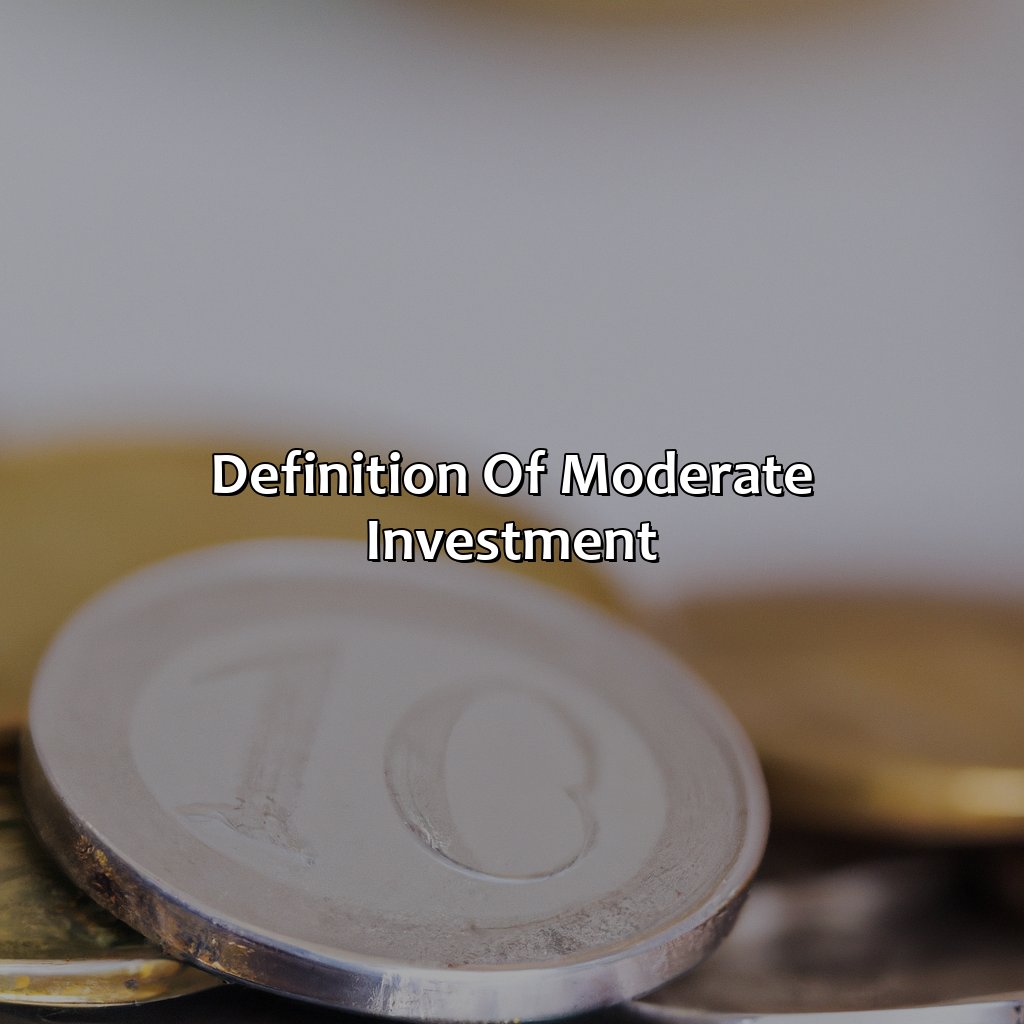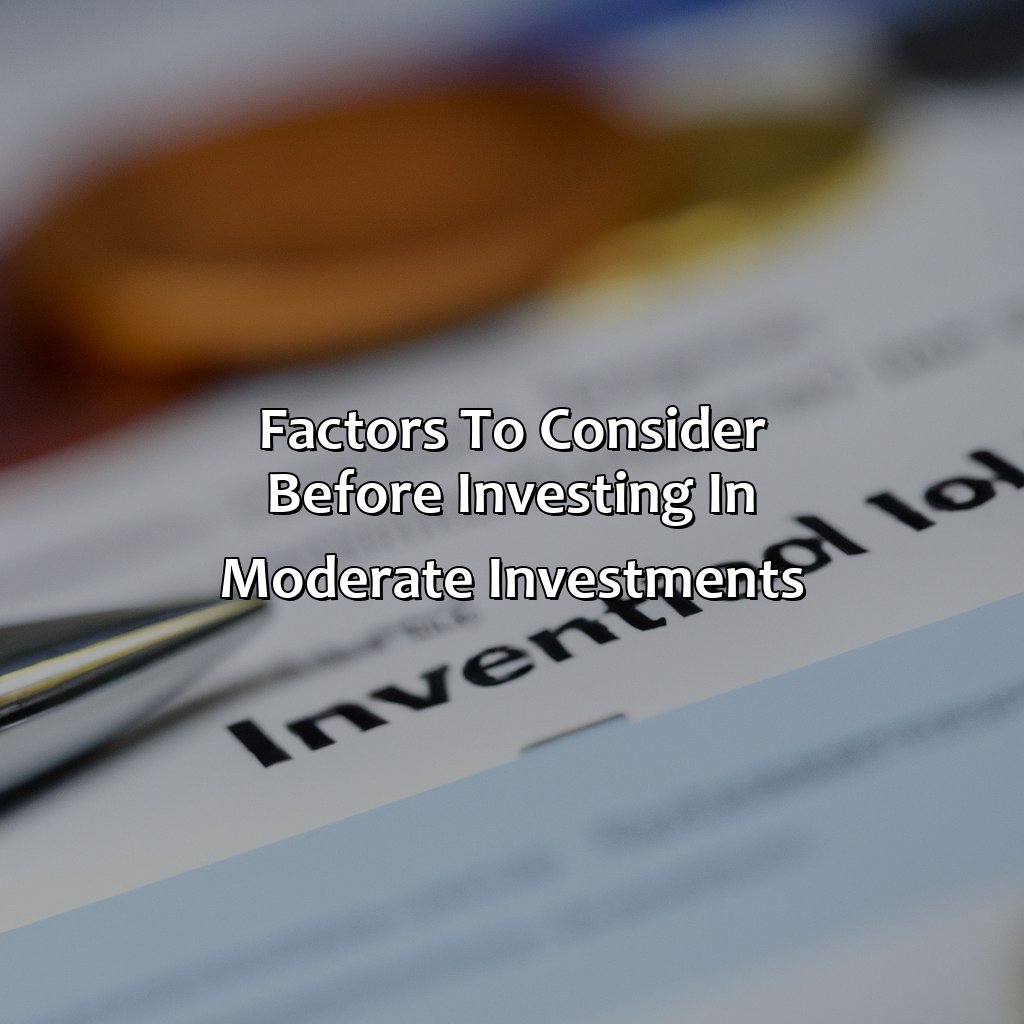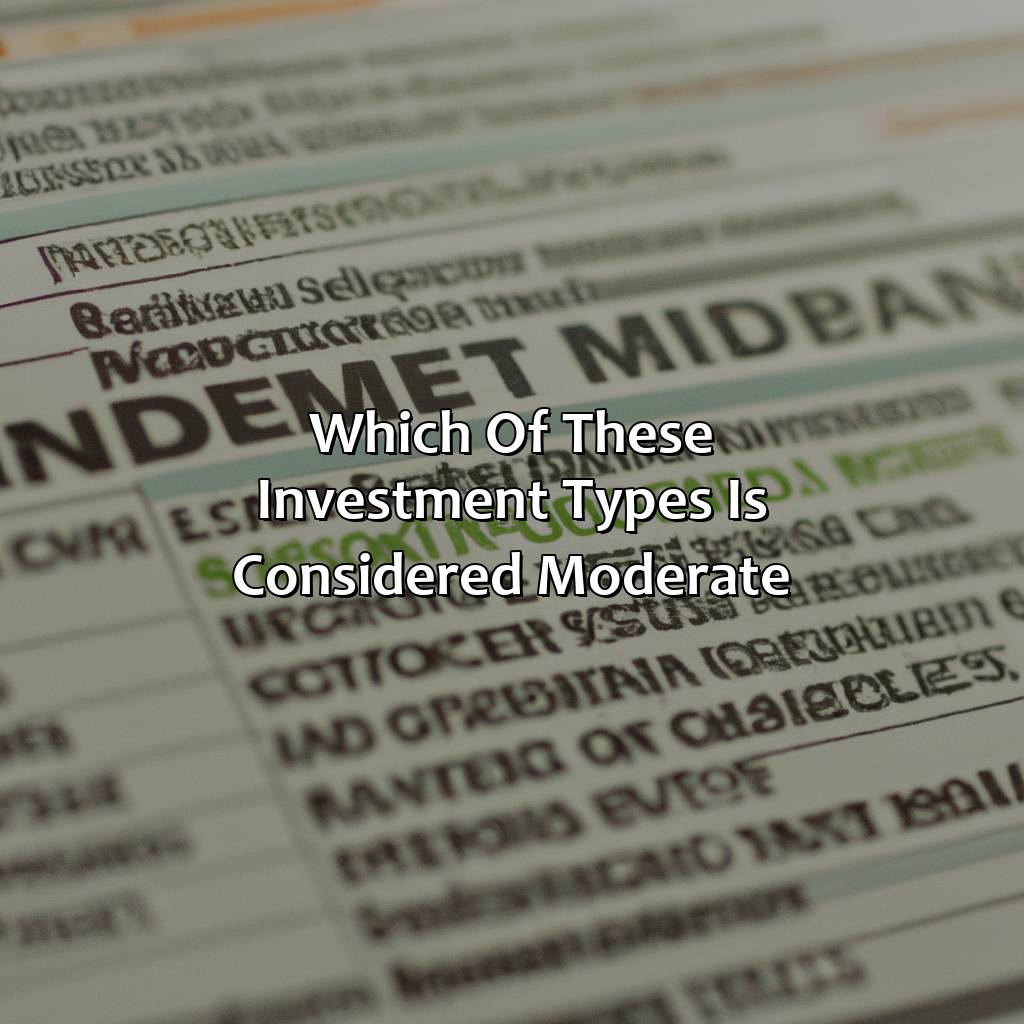Which Of These Investment Types Is Considered Moderate?
Key Takeaways:
- Investments with balanced risk and return, diversification, and investment in established companies or stable industries are considered moderate.
- Types of moderate investments include bond funds, dividend-paying stocks, real estate investment trusts (REITs), target-date funds, index funds, and balanced funds.
- Before investing in moderate investments, it is important to consider investment goals, time horizon, and risk tolerance.
Have you ever wondered which investment options offer you the most moderate risk? Our article explores the different types of investments to help you find the one that fits your financial goals and personality. You’ll learn why each of these investment options may have some risk, but are considered to be moderate in nature.
Definition of moderate investment
Investment types can range from low-risk to high-risk. Moderate investment falls in between, providing moderate returns without exposing investors to excessive risks. A moderate investment strategy aims to balance potential returns with risk management and diversification. Usually, moderate investments include diversified portfolios made up of stocks, bonds, and other securities across various industries and sectors.
A diversified portfolio is one where investors can distribute their funds across multiple stocks, bonds, and other securities, reducing risk exposure. Since it includes a mix of both high-risk and low-risk investments, it can yield moderate returns while spreading risk. Mutual funds, index funds, and exchange-traded funds (ETFs) are some investment types that can offer a moderate investment approach.
Investors may use a variety of strategies to reduce risks and ensure moderate returns, such as creating balanced portfolios, analyzing market trends and performance histories, and staying informed about current events. A buy-and-hold approach with a long-term outlook can help avoid making impulsive decisions based on short-term market fluctuations. Regular portfolio rebalancing is also recommended to maintain optimal diversification and risk management.
Investing in moderate-risk investments is an excellent strategy for investors seeking predictable returns without assuming excessive risk. It is essential to do thorough research and understand the risk-reward tradeoff before investing in any investment type. By diversifying portfolios and adopting a disciplined investment approach, investors can achieve their financial goals and grow their wealth over time.

Image credits: retiregenz.com by Joel Washington
Characteristics of moderate investments
To comprehend moderate investments, explore the characteristics that define them. Risk and return balanced, diversified and invested in established companies or stable industries. These sub-sections will give you an overall view of moderate investments. By investigating these sections, you can get an insight into how moderate investments work.

Image credits: retiregenz.com by Harry Duncun
Balanced risk and return
Investments that provide a balance between risk and return are considered moderate. These investments aim to achieve reasonable returns with relatively low risks. They are suitable for investors who aim to grow their wealth while maintaining a certain level of security.
Moderate investments can be made in various types of assets, such as mutual funds, exchange-traded funds, and bonds. These investment options aim to diversify the investor’s portfolio while ensuring a reasonable degree of stability. A balanced fund is an example of a moderate investment that invests in both stocks and bonds, balancing the risk and returns.
Unlike high-risk investments, moderate investments do not promise exorbitant returns but offer stable returns over time. Therefore, it’s important for investors to choose investment options based on their goals and willingness to take risks.
Low-risk tolerance investors must consider investing in moderate investments due to the potential risks associated with high-risk investments. Diversifying the portfolio with moderate investments can help reduce exposure to market volatility while maintaining potential growth opportunities.
According to Forbes, “assets under management (AUM) at Robo-advisors reached $460 billion as of end-May 2021.”
“Why put all your eggs in one basket when you can diversify and have an omelette?”
Diversification
Investment diversification typically involves investing in a variety of assets to minimize risks and maximize returns. By allocating investments across several different asset classes, like stocks, bonds, real estate, or commodities, investors can reduce the impact of any one asset’s volatility on their overall portfolio. Diversification strategies may vary based on investment goals, risk tolerance and financial situation.
Moreover, diversification also extends to geographical locations and industries. By putting money in different geographic regions and sectors such as technology or healthcare, investors can safeguard against regional risks that may affect one industry.
It is crucial for investors to work with a professional financial advisor to determine individual diversification strategies in the context of their specific investment objectives and risk appetite.
For instance, a new investor might add a small percentage of funds into higher-risk investments such as small-cap stocks alongside low-risk government bond funds when building their portfolio. While such high-risk options might offer significant gains over time; they are associated with increased market volatility. A well-diversified investment strategy will ensure optimal return while minimizing loss.
Put your money in stable industries, because nothing says ‘moderate investment’ like a business that’s been around longer than you have.
Investment in established companies or stable industries
Investing in well-established companies or industries with a stable track record is often considered a moderate investment choice. This type of investment offers reliable returns, lower risk, and the potential for long-term growth. Companies and industries that have established themselves as leaders in their sector are typically less susceptible to market fluctuations and tend to have well-developed systems in place to weather economic challenges.
These types of investments are widely popular among investors due to their steady performance over time. They offer relatively low risk with good chances of profitability. Furthermore, these investments also have the potential for passive income streams through dividends or interest payments. Another advantage is that they tend to hold up well during economic downturns.
Choosing to invest in an established firm or industry requires adequate research on the economic prospects and the company’s financial history. It is also essential to keep tabs on evolving trends and disruptive innovations that could impact the industry’s stability.
One example of an industry that has remained relatively stable over time is healthcare. Companies involved in medical devices, pharmaceuticals, hospitals, health insurance providers are among those still performing decently even during hard times.
Some moderate investments are like the middle child – not too risky but not too safe either, always trying to please their parents.
Types of moderate investments
Investment options for the moderate investor? Look into bond funds, dividend-paying stocks, REITs, target-date funds, index funds, and balanced funds.
Evaluate the advantages of each one. Decide which is best for you.

Image credits: retiregenz.com by Harry Duncun
Bond funds
One moderate investment option is investing in fixed income securities known as Bond funds. These types of funds offer investors a stable and predictable return on their investment. Bond funds invest in government, corporate, or municipal bonds. Generally, these bonds have less risk than investing in the stock market, making them a popular choice for moderate investors.
With bond funds, investors obtain access to a diversified portfolio of individual bonds that are managed by experts. The fund managers choose the type of bonds to invest in based on anticipated changes in interest rates and credit risk. This way, investments are spread across various industries, companies, and geographic regions to ensure low or moderate risk.
Moreover, bond funds typically have lower fees than other types of mutual funds or exchange-traded funds (ETFs). However, some bond funds carry higher risks such as credit risks where the issuer may fail to make payments as agreed. Also, changes in interest rates may result in fluctuations of investor returns.
To reduce the risks associated with bond fund investments, an investor can consider diversifying their portfolios. For instance, they can invest across various sectors like energy or technology and incorporate other moderate investment options like index tracking mutual/DIY EFTs or balanced mutual/DIY EFTs.
Investing in dividend-paying stocks is like having a sugar daddy that keeps on giving, but without the guilt and emotional baggage.
Dividend-paying stocks
Investing in shares is a moderate financial strategy that offers promising returns. Unlike other investment types, dividend-producing equities are one of the most reliable sources of regular income for investors. With dividends, investors make passive income while still holding onto the stocks.
One advantage of investing in dividend-paying stocks is their stable and predictable nature, making them an attractive option for conservative investors. While market value fluctuates this type of equity tends to remain steady, providing consistent dividends even in market downturns.
Fund managers also recommend dividend-paying stocks for their potential growth, as the companies with higher earnings tend to pay higher dividends. Additionally, some bluechip firms have been paying dividends consistently over several decades, making them an ideal long-term investment option.
However, it’s essential to conduct thorough research before committing to investing in individual dividend-paying stocks. Factors such as company financials and management credibility must be analyzed carefully to minimize risks and maximize profits.
Don’t miss out on earning regular income with moderate investments such as investing in dividend-paying securities; save actively today!
Investing in REITs is like having a tenant who never complains, leaves a mess, or pays rent on time…wait.
Real estate investment trusts (REITs)
Real estate investment trusts are investments that involve pooling funds from multiple investors to purchase income-generating real estate properties, such as commercial buildings, apartments, and shopping centers. These trusts generate returns for investors through rent or leasing income and property appreciation. REITs provide an easily accessible way for small investors to invest in real estate and receive a share of the profits.
Moreover, the diversification of assets within a REIT offers moderate risk with high potential returns due to their relationship with the real estate market. Unlike traditional property ownership, REIT shareholders do not hold direct ownership in their assets but instead own shares that can be sold at any time.
Investing in the right type of moderate investment is crucial because it can bolster your financial portfolio while generating passive weekly or monthly returns. Don’t miss out on this valuable opportunity to make money through real estate investments by overlooking REITs as an excellent medium-risk investment opportunity.
If only target-date funds could predict the target of my next Tinder match with the same accuracy.
Target-date funds
- These funds are designed to adjust automatically over time.
- They offer convenience and simplicity for those seeking a long-term investment strategy.
- Investors can choose the appropriate fund based on their anticipated retirement date.
- The allocation of assets is adjusted periodically based on the fund’s stated objective.
It is important to note that target-date funds do not guarantee a profit or eliminate risk. However, they offer an effective way to diversify investments and reduce risk based on an investor’s projected retirement date.
For investors looking for a hassle-free way to invest in different asset classes that adjusts automatically based on the investor’s intended retirement age, target-date funds are a great option. Don’t miss out on potentially better returns with this moderate investment choice.
Index funds – because sometimes it’s better to let a robot handle your investments than your own impulsive tendencies.
Index funds
Investing in index funds can have the following benefits:
- Low Cost- As the fund is passively managed, the fees and expenses are much lower compared to actively managed funds.
- Diversification- These funds invest in the entire stock market indexes, thus reducing risk as it diversifies your portfolio investment holdings across different assets.
- Tax-Efficient- The turnover of stocks in these funds is minimal, resulting in lower capital gains taxes and maximizing your returns on investment
It is essential to note that index funds do not require any expertise or prior knowledge of investing. With its low cost and diversified portfolios, this option ensures a steady return on investment for a longer duration.
Balanced funds: because life is all about finding the right balance, even in investments.
Balanced funds
Balanced investment portfolios are a popular choice for moderate investment options. Here’s a rundown on the essentials of this option:
- They are balanced between growth and income securities to reduce risk
- Asset allocation is carried out according to the investor’s need
- Typically, they comprise 60% equity funds and 40% bond funds
- The investor receives regular income in the form of dividends or interest
- Aiming for preservation of capital along with modest returns within a medium term.
- Offers diversification through an assortment of asset classes.
To further maximise your returns and reduce risks, consider exploring fixed-income securities. These would provide an additional layer of protection against market fluctuations. Investing in dividend reinvestment plans is also beneficial to increase yields over time.
Before jumping into moderate investments, remember to do your due diligence or else you might end up with moderate returns and a whole lot of regret.
Factors to consider before investing in moderate investments
Understand factors that affect your investment choice. Assess goals, time horizon, and risk tolerance. This will help you pick the best option. Learn more in this section to make a well-informed decision!

Image credits: retiregenz.com by Yuval Woodhock
Investment goals
For any investor, determining their investment objective is crucial before deciding on the type of investment to make. The investment goals could range from short-term gains to long-term growth. Depending on the investor’s goals, they can choose from various investment types that are considered moderate. These options may include a mix of equities and bonds or funds that balance risk and reward.
Investors should also consider their risk tolerance in choosing moderate investments. They must ensure that the returns match their financial goals without being overly risky, leading to potential losses.
In summary, selecting moderate investments for sound financial management requires an understanding of individual objectives and balancing risks with rewards.
According to a report by Forbes, diversifying investment portfolios help investors mitigate risks while achieving stable returns.
Time is money, but a longer time horizon means investing in moderate options can pay off like a slow-cooked brisket – tender and satisfying in the end.
Time horizon
The duration within which an investment is expected to be held is an essential consideration for moderate investments. This duration, also referred to as the investment time horizon, often ranges from several months to a few years.
Investment time horizons allow investors to determine the suitable type of moderate investments that align with their financial objectives and goals. Shorter time horizons and those closer to retirement may prefer moderate investment types that provide steady income streams and lower risk levels. In contrast, longer investment horizons may be more suited for moderate investments that offer higher risks levels but greater returns.
Additionally, assessing investment time horizons allows investors to prepare themselves for any potential market fluctuations or economic changes, which can have significant effects on their medium-term assets.
For example, a middle-aged couple looking to invest in a rental property would need to consider how long they plan on holding the property before selling it. Perhaps they want it until retirement or want it long-term as an income stream. Their chosen medium-term asset will rely on their intended length of ownership.
Risk tolerance is like a game of Jenga, always teetering on the brink of collapse when you realize you invested more than you should have.
Risk tolerance
Assessing your comfort zone with investment risks is crucial and can be evaluated by examining your “risk appetite.” It is essential to understand your risk tolerance level before making any investment decisions. Factors such as age, financial goals, and investment experience can help you determine how much risk you can tolerate. Conservative investors usually prefer low-risk schemes such as government bonds or fixed deposits, while aggressive investors opt for high-growth, high-risk investments such as stocks or cryptocurrencies.
When investing in moderate investments, it’s important to note that although they contain a higher degree of risk than low-risk options, they also have the potential to generate significant returns. Moderate options are best suited for investors who want to take calculated risks but still want to maintain a balanced portfolio. They can include products like index funds or mutual funds that have a fair mix of equities and fixed-income securities.
Other aspects worth considering when investing in moderate schemes are factors like market trends and economic performance since uncertainty in these areas may cause fluctuations in stock prices and bond yields. Additionally, inflation rates might erode returns from low-yield investments such as bonds, making them less attractive for investors looking for long-term results.
If you’re hesitant about investing but don’t want to miss out on potential opportunities due to fear of loss or lack of knowledge, consult with an experienced financial planner who can help you make informed choices based on your personal circumstances and goals. Investing comes with risks; however, not taking action could mean missing out on potential gains that could positively shape your financial future.
Five Facts About Moderate Investments:
Moderate investments typically provide a balance of risk and return. (Source: The Balance)
Examples of moderate investments include balanced funds, target-date funds, and index funds. (Source: NerdWallet)
Moderate investments may include a mix of stocks, bonds, and other securities. (Source: Investopedia)
Moderate investments are often recommended for investors who are not comfortable with high levels of risk but want higher returns than conservative investments. (Source: Forbes)
The expected return for moderate investments is typically between 6-10%. (Source: The Motley Fool)
FAQs about Which Of These Investment Types Is Considered Moderate?
Which of these investment types is considered moderate?
In general, a moderate investment type is one that provides a balance between risk and reward. Some examples of moderate investment types include mutual funds, exchange-traded funds (ETFs), and index funds.
What are mutual funds?
Mutual funds are investment vehicles that pool money from multiple investors to purchase a diversified portfolio of stocks, bonds, or other securities. They are managed by professional fund managers and offer a way for individual investors to access a broader range of investments than they might be able to on their own.
What are exchange-traded funds (ETFs)?
ETFs are similar to mutual funds in that they are also investment vehicles that hold a diversified portfolio of securities. However, ETFs are traded on stock exchanges like individual stocks, and can be bought and sold throughout the day at market prices. This gives investors more flexibility and transparency than mutual funds.
What are index funds?
Index funds are a type of mutual fund or ETF that seeks to match the performance of a specific market index, such as the S&P 500 or the Dow Jones Industrial Average. Because they are passively managed and require less research and analysis than actively managed funds, index funds typically have lower fees than other types of investments.
What are some other examples of moderate investments?
In addition to mutual funds, ETFs, and index funds, some other examples of moderate investments include balanced funds, target-date funds, and real estate investment trusts (REITs). These investments vary in terms of their risk and potential returns, so it’s important to do your research and choose the one that best fits your individual financial goals and risk tolerance.
How can I determine my risk tolerance?
Your risk tolerance is influenced by a variety of factors, including your age, income, financial goals, and personal preferences. To determine your risk tolerance, you can take an online quiz or consult with a financial advisor. It’s important to remember that investing involves some degree of risk, so it’s important to choose investments that align with your overall financial plan and the level of risk you are comfortable with.
 Checkout this IRS Loophole
Checkout this IRS Loophole 
